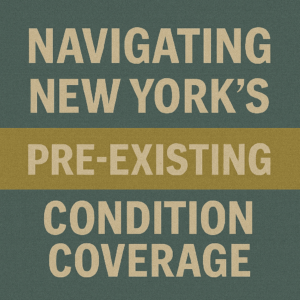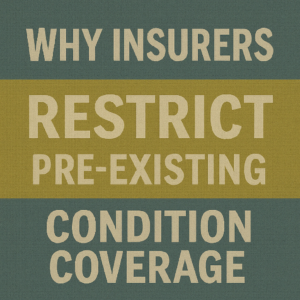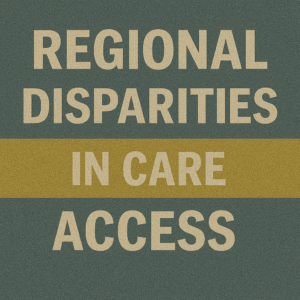Navigating New York’s Pre-Existing Condition Coverage
For New Yorkers managing chronic health conditions, securing comprehensive insurance coverage remains a significant challenge. While state and federal laws provide important protections, NY pre-existing coverage gaps continue to affect thousands of residents—limiting access to essential treatments, creating financial burdens, and causing unnecessary stress for patients and families.
A common question we hear is: “Does NY deny pre-existing condition coverage?” While insurers cannot outright deny coverage thanks to the Affordable Care Act (ACA), many New Yorkers still face pre-existing denial in NY insurance through:
- High out-of-pocket costs
- Limited provider networks
- Bureaucratic hurdles
- Restrictions on certain treatments
This comprehensive guide will help you understand:
- Who’s most affected by coverage gaps
- Why insurers restrict care for pre-existing conditions
- Your legal protections and appeal options
- How to find better coverage and reduce costs
- Recent policy changes affecting coverage

NY Pre-Existing Coverage Gaps: Who Is Most at Risk?
Despite strong consumer protections, these groups face the biggest challenges:
1. Low-Income Individuals Above Medicaid Limits
- NY’s Medicaid covers those earning up to 138% of federal poverty level ($20,120/year for individual)
- Coverage gap affects those earning slightly more who can’t afford private plans
- Example: Single adult earning $25,000/year may pay $200+/month for marketplace plan with $6,000 deductible
2. Freelancers and Gig Workers
- 1.3 million NY independent workers lack employer-sponsored insurance
- Marketplace plans often have high deductibles ($4,000-$8,000)
- Pre-existing access problems NY worsen when needing frequent specialist care
3. Seniors (60-64) Not Yet Medicare-Eligible
- Private insurance costs average $1,200/month for this age group
- 23% delay care due to costs (NY State Health Foundation data)
4. Patients with Rare/Complex Conditions
- 15% of NYers have conditions requiring specialty drugs
- Many face annual costs exceeding $50,000 after insurance
Comparison of NY Health Insurance Options
| Plan Type | Income Limits | Pre-Existing Coverage | Avg. Monthly Cost | Key Advantage | Main Drawback |
| Medicaid | Up to 138% FPL | Full coverage | $0 | $0 premiums | Limited specialists |
| Essential Plan | 138-200% FPL | Full coverage | $0-$20 | Low-cost | Fewer providers |
| Marketplace Silver | No upper limit | Covered | $200-$600 | ACA protections | High deductibles |
| Employer Plans | N/A | Covered | $100-$400 | Best coverage | Job-dependent |
| Medicare | 65+ or disabled | Covered after 24 months | $170+ | Nationwide network | Gaps in drug coverage |
FPL = Federal Poverty Level. 2024 numbers for a single individual.

Why Insurers Restrict Pre-Existing Condition Coverage
Though the ACA bans outright denials, insurers use these tactics to limit costs:
1. Prior Authorization Requirements
- 89% of NY doctors report increased PA requirements (AMA data)
- Average processing time: 14 business days
- 25% of requests initially denied
2. Step Therapy (“Fail First”) Policies
- Required for 45% of specialty medications
- Patients often must try 2-3 cheaper alternatives first
- Can delay proper treatment by 3-6 months
3. Narrow Provider Networks
- 30% of marketplace plans are “narrow network”
- Upstate residents travel 2-3x farther for specialists
4. High Cost-Sharing
- Average deductible for silver plans: $4,500
- Specialty drug copays often $100-$250 per prescription
How to Fight Denials: A Step-by-Step Guide
1. Request Detailed Denial Letter
- Insurers must provide specific denial reasons within 15 days
- Common reasons: “Not medically necessary,” “Investigational”
2. File Internal Appeal
- Submit within 180 days of denial
- Include:
- Doctor’s letter of medical necessity
- Peer-reviewed studies
- Treatment guidelines
3. Request External Review
- Available if internal appeal fails
- NY DFS oversees independent review process
- 45% of external appeals overturn denials
Legal Protections
- ACA Guaranteed Issue: No health-based denials
- NY State Law: 30-day appeal deadline for insurers
- Surprise Bill Law: Protects against out-of-network charges
For assistance, contact: Phone: 845.753.2320 (Local) | 888.215.4045 (Toll-Free) Email: [email protected]

Regional Disparities in Care Access
| Region | Specialist Wait Time | Key Challenges |
| NYC | 2-4 weeks | High costs, but most specialists |
| Long Island | 3-6 weeks | Limited mental health providers |
| Hudson Valley | 4-8 weeks | Few endocrinologists/rheumatologists |
| Upstate | 8-12 weeks | Hospital closures, travel distances |
Recent Policy Changes Affecting Coverage
2024 Updates
- Enhanced Marketplace Subsidies
- Income cap removed for subsidy eligibility
- 45,000 more NYers now qualify for $0 premium plans
- Prescription Drug Reform
- $200/month insulin copay cap
- New rules limiting specialty drug step therapy
- Telehealth Expansion
- Insurers must cover virtual visits equally
- 85 more conditions now eligible for telehealth
FAQ
1. Can insurers charge me more due to my condition?
No—the ACA prohibits health-based pricing. Costs can only vary by age, location, and tobacco use.
2. What if my treatment is deemed “experimental”?
Appeal with:
- FDA approval documents
- Medical journal studies
- Letters from specialists
3. Are short-term plans ever a good option?
Generally no—they can:
- Exclude pre-existing conditions
- Cap annual benefits
- Lack ACA protections
4. How do I report unfair practices?
Contact:
- NY DFS: www.dfs.ny.gov
- NY Attorney General: 800-771-7755
5. What’s changing in 2025?
Proposed legislation would:
- Further limit step therapy
- Require faster prior authorization decisions
- Expand Essential Plan eligibility
Final Recommendations
- Review Annually: Network formularies change each year
- Document Everything: Keep denial letters and appeal records
- Seek Help: Free enrollment assistance available at NYHealthInsurer.com
For personalized guidance: Phone: 845.753.2320 (Local) Toll-Free: 888.215.4045 Email: [email protected]
By understanding these systems and your rights, you can better navigate NY’s complex insurance landscape and secure the coverage you need for your health conditions.